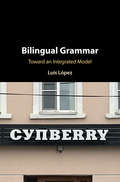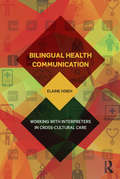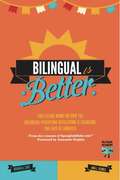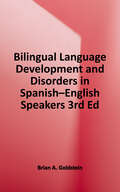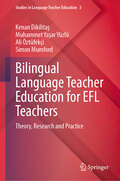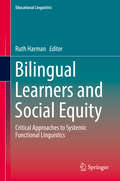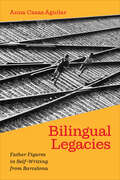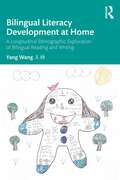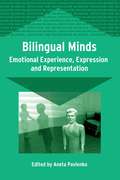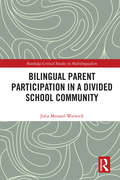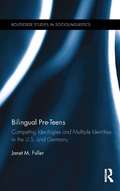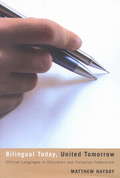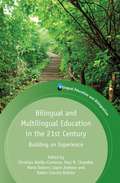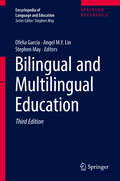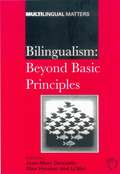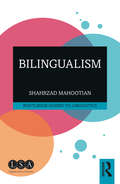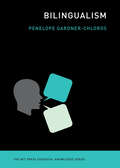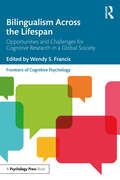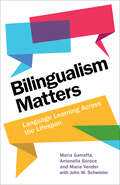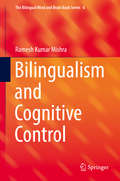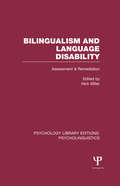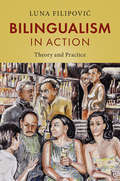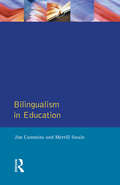- Table View
- List View
Bilingual Grammar: Toward an Integrated Model
by Luis LópezDoes a bilingual person have two separate lexicons and two separate grammatical systems? Or should the bilingual linguistic competence be regarded as an integrated system? This book explores this issue, which is central to current debate in the study of bilingualism, and argues for an integrated hypothesis: the linguistic competence of an individual is a single cognitive faculty, and the bilingual mind should not be regarded as fundamentally different from the monolingual one. This conclusion is backed up with a variety of empirical data, in particular code-switching, drawn from a variety of bilingual pairs. The book introduces key notions in minimalism and distributed morphology, making them accessible to readers with different scholarly foci. This book is of interest to those working in linguistics and psycholinguistics, especially bilingualism, code-switching, and the lexicon.
Bilingual Health Communication: Working with Interpreters in Cross-Cultural Care
by Elaine HsiehThis book examines interpreter-mediated medical encounters and focuses primarily on the phenomenon of bilingual health care. It highlights the interactive and coordinated nature of interpreter-mediated interactions. Elaine Hsieh has put together over 15 hours of interpreter-mediated medical encounters, interview data with 26 interpreters from 17 different cultures/languages, 39 health care providers from 5 clinical specialties, and surveys of 293 providers from 5 clinical specialties. The depth and richness of the data allows for the presentation of a theoretical framework that is not restricted by language combination or clinical contexts. This will be the first book of its kind that includes not only interpreters’ perspectives but also the needs and perspectives of providers from various clinical specialties. Bilingual Health Communication presents an opportunity to lay out a new theoretical framework related to bilingual health care and connects the latest findings from multiple disciplines. This volume presents future research directions that promise development for both theory and practice in the field.
Bilingual Is Better
by Roxana A. Soto Ana L. FloresFor years immigrants were told that the only way for their children to embrace American culture was to leave behind their heritage language and speak only English. But what if this advice was based solely on political motives and not the wellbeing of children? What if the truth was that all children in America, regardless of their cultural background, would actually benefit from learning two languages? The answer to this question has sparked a new Latino parenting revolution, which is changing the face of America. Roxana and Ana, founders of the wildly successful parenting blog SpanglishBaby, are part of a growing movement of Latino parents who are proudly reclaiming their language and cultural heritage for themselves and their children. Laugh and cry with them as they stumble through the ups and downs of raising bilingual, bicultural children in America and discover themselves in the process. This inspiring parenting memoir includes practical tips and resources to help parents from all backgrounds give their children the benefits of bilingualism. Bilingual Is Better debunks old stereotypes while shedding new light on hot topics like bilingual education, cultural heritage and what it really means to be Latino. A perfect blend of hilarious anecdotes and solid research, this book is a fun, engaging read which is sure to spark conversation and positive change. Roxana A. Soto and Ana L. Flores co-founded the popular parenting blog SpanglishBaby, which was recently named a Must Read Mom's Blog by Parenting magazine. Both authors are well known, award-winning bilingual journalists.
Bilingual Language Development & Disorders In Spanish-english Speakers
by Barbara Zurer Pearson Nan Bernstein Ratner Janet L. Patterson Li Sheng Raúl Rojas Brian A. Goldstein Carol Scheffner Hammer Barbara Rodríguez Megha Sundara Adriana Soto-Corominas Ellen Stubbe Kester Solaman J. Cooperson Raquel T. Anderson Aquiles Iglesias M. Adelaida Restrepo Kai Greene Christine E. Fiestas Megan Dunn Davison María R. Brea Christina Gildersleeve-Neumann Lucía I. Méndez Sonja Pruitt-Lord Elizabeth D. Peña Lisa Bedore Lisa Lopez Kelly Escobar Julie C. SmithDual language learners are the fastest-growing segment of the U.S. student population, and the majority speak Spanish as a first language. This graduate-level textbook—now in its third edition—gives future speech-language pathologists the comprehensive knowledge they need to work effectively with Spanish–English bilingual children and support their language development. Aligned with current best practices and updated with the latest research and new chapters on critical topics, this book prepares SLPs for practice with cutting-edge information on language development and disorders of Spanish–English bilingual children. More than 25 leading researchers compile the high-level knowledge SLPs need to understand the complexity of language development in bilingual children, distinguish language differences from disorders accurately, and conduct effective assessment and intervention. An essential graduate text that will also be a trusted reference for practicing professionals, this third edition gives current and future SLPs a broad, deep, and nuanced understanding of communication development and disorders in Spanish–English bilingual children.
Bilingual Language Teacher Education for EFL Teachers: Theory, Research and Practice (Studies in Language Teacher Education #3)
by Kenan Dikilitaş Muhammet Yaşar Yüzlü Ali Öztüfekçi Simon MumfordThis book is designed for English as a foreign language (EFL) teachers to shape their teaching practices and integrate bilingual education. It investigates the emerging context of bilingualism in schools where non-bilingual children are taught both through their native language and English as the second language.· Part I focuses on the theoretical underpinnings of bilingualism in EFL contexts. · Part II explores empirical research into bilingual teaching education. · Part III provides teaching pedagogies embracing dynamic bilingualism in EFL contexts and offers practical suggestions for EFL teachers creating instructional and interactional spaces.· Part IV is dedicated to practice-based, hands-on activities both for pre-service and in-service EFL teachers. This book is intended for language teachers, students in language teacher education graduate programs, researchers in EFL contexts, and language teacher educators and trainers. It empowers stakeholders to re-envision, and ultimately transform, bilingual education critically and practically, promoting the building of stronger identities.
Bilingual Learners and Social Equity: Critical Approaches to Systemic Functional Linguistics (Educational Linguistics #33)
by Ruth HarmanThis volume explores how educators conceptualized and implemented critical approaches to systemic functional linguistics that support bilingual students in appropriating and challenging dominant knowledge domains in K-16 contexts. The researchers exhibit a shared commitment to enacting a culturally sustaining SFL praxis that validates multilingual meaning making, pushes against social inequity, and fosters creative re-mixing of available semiotic resources. It should prove a valuable resource for students, teachers and researchers interested in applied linguistics, education and critical theory.
Bilingual Legacies: Father Figures in Self-Writing from Barcelona (Toronto Iberic)
by Anna Casas AguilarBilingual Legacies examines fatherhood in the work of four canonical Spanish authors born in Barcelona and raised during the dictatorship of Francisco Franco. Drawing on the autobiographical texts of Juan Goytisolo, Carlos Barral, Terenci Moix, and Clara Janés, the book explores how these authors understood gender roles and paternal figures as well as how they positioned themselves in relation to Spanish and Catalan literary traditions. Anna Casas Aguilar contends that through their presentation of father figures, these authors subvert static ideas surrounding fatherhood. She argues that this diversity was crucial in opening the door to revised gender models in Spain during the democratic period. Moving beyond the shadow of the dictator, Casas Aguilar shows how these writers distinguished between the patriarchal "father of the nation" and their own paternal figures. In doing so, Bilingual Legacies sheds light on the complexity of Spanish conceptions of gender, language, and family and illustrates how notions of masculinity, authorship, and canon are interrelated.
Bilingual Literacy Development at Home: A Longitudinal Ethnographic Exploration of Bilingual Reading and Writing
by Yang WangThis book explores pedagogical implications for how children read, write, respond to literature, and begin to learn an additional language in the home context.Using a longitudinal ethnographic study, it explores a bilingual child’s literacy development over a span of four years from kindergarten to the third grade in a real-life home context in the United States. Written from a parent-researcher’s perspective, it illustrates the child’s Mandarin Chinese and English language support at home and in the community during the pandemic, and charts the development in bilingual reading and writing, multimodal reading responses to children’s literature, and learning Spanish as a third language. Through rich and detailed descriptions, the case study methodology allows a clear articulation of the project’s focus and foregrounds the exploration of reading as a sociopsycholinguistic process, as well as highlighting multimodality in reading and writing responses, translanguaging, and bilingual and bicultural identities to study and teach culturally and linguistically diverse children.It will be a valuable resource for literacy researchers, scholars, and bilingual educators with interests in sociolinguistics, literacy education, bilingualism, and translanguaging.
Bilingual Minds
by Aneta PavlenkoDo bi- and multilinguals perceive themselves differently in their respective languages? Do they experience different emotions? How do they express emotions and do they have a favourite language for emotional expression? How are emotion words and concepts represented in the bi- and multilingual lexicons? This ground-breaking book opens up a new field of study, bilingualism and emotions, and provides intriguing answers to these and many related questions.
Bilingual Parent Participation in a Divided School Community (Routledge Critical Studies in Multilingualism)
by Julia Menard-WarwickThis volume theorizes parent participation in a bilingual school community in California, unpacking broader issues around language ideologies, language and power, and parent collaboration in diverse educational contexts. Highlighting data from a two-year ethnographic study of the school community, the book grounds this discussion in theories of discourse and bilingualism, with a focus on translanguaging and translingual practice. The volume points to a range of challenges and questions posed by the parents’ efforts to unite as a single school community, including linguistic inequality, cultural divides, and differing implicit beliefs on language. The book documents these efforts as a means to demonstrate the ways in which monolingual practices are reinforced in these settings, despite best efforts, but also as a point of departure to discuss implications and a way forward for parent collaboration in bilingual school communities more generally. Offering a nuanced portrait of the impact of parent collaboration in bilingual school communities, this volume will be of particular interest to graduate students and scholars in language education, applied linguistics, bilingualism, and sociolinguistics.
Bilingual Pre-Teens: Competing Ideologies and Multiple Identities in the U.S. and Germany (Routledge Studies in Sociolinguistics #6)
by Janet M. FullerThis volume examines the connection between socio-economic class and bilingual practices, a previously under-researched area, through looking at differences in bilingual settings that are classified as "immigrant" or "elite" and are thus linked to socio-economic class categories. Fuller chooses for this examination bilingual pre-teen children in Germany and the U.S. in order to demonstrate how local identities are embedded in a wider social world and how ideologies and identities both produce and reproduce each other. In so doing, she argues that while pre-teen children are clearly influenced by macro-level ideologies, they also have agency in how they choose to construct their identities with relation to hegemonic societal discourses, and have many other motivations and identities aside from social class membership which shape their linguistic practices.
Bilingual Today, United Tomorrow: Official Languages in Education and Canadian Federalism
by Matthew HaydayHayday shows how the language programs and policies initiated by the Trudeau government supported French-Canadian and Acadian minority communities, enabling them to develop minority language education systems and laying the groundwork for the minority language education rights contained in section 23 of the Canadian Charter of Rights and Freedoms. He examines how the dynamics of Canadian federalism shaped the implementation and development of language policy in six Canadian provinces and shows how advocates of these programs - politicians, bureaucrats, parents, lobbyists, and teachers - worked to ensure their success. These dynamic programs not only guaranteed minority language education rights but dramatically increased access to French second language instruction, particularly through the innovative new sector of French immersion.
Bilingual Writers and Corpus Analysis (Routledge Studies in Applied Linguistics)
by David M. Palfreyman Nizar HabashThis innovative volume is one of the first to represent the usage of bilingual writers in both their languages, offering insight into language corpora as extremely valuable tools in contemporary applied linguistics research, and in turn, into how much of the world’s population operate daily. This book discusses one of the first examples of a bilingual writer corpus, the Zayed Arabic-English Bilingual Undergraduate Corpus (ZAEBUC), which includes writing by hundreds of students in two languages, with additional information about the writers and the texts. The result is a rich resource for research in multilingual use and learning of language. The book takes the reader through the design and use of such a corpus and illustrates the potential of this type of corpus with detailed studies that show how assessment, vocabulary, and discourse work across two very different languages. This volume will be of interest to scholars, policymakers, and educators in bilingualism, plurilingualism, language education, corpus design, and natural language processing.
Bilingual and Multilingual Education in the 21st Century
by Christian Abello-Contesse Paul M ChandlerBilingual education is one of the fastest growing disciplines within applied linguistics. This book includes the work of 20 specialists working in various educational contexts across Europe, Latin America and North America to create a volume which is both comprehensive in scope and multidimensional in its coverage of current bilingual initiatives. The central themes of this volume, which draws on past experiences of bilingual education, include issues in language use in classrooms at elementary, secondary and tertiary levels; participant perspectives on bilingual education experiences; and the language needs of bi- and multilingual students in monolingual schools. This collection will be of interest to teachers and administrators in bi- and multilingual education programs, as well as scholars working in the field of language education.
Bilingual and Multilingual Education: Implications For Sla, Tesol, And Bilingual Education (Encyclopedia of Language and Education #Vol. 5)
by Ofelia García Stephen May Angel M. Y. LinIn this third, fully revised edition, the 10 volume Encyclopedia of Language and Education offers the newest developments, including an entirely new volume of research and scholarly content, essential to the field of language teaching and learning in the age of globalization. In the selection of topics and contributors, the Encyclopedia reflects the depth of disciplinary knowledge, breadth of interdisciplinary perspective, and diversity of socio-geographic experience in the language and education field. Throughout, there is an inclusion of contributions from non-English speaking and non-western parts of the world, providing truly global coverage. Furthermore, the authors have sought to integrate these voices fully into the whole, rather than as special cases or international perspectives in separate sections. The Encyclopedia is a necessary reference set for every university and college library in the world that serves a faculty or school of education, as well as being highly relevant to the fields of applied and socio-linguistics. The publication of this work charts the further deepening and broadening of the field of language and education since the publication of the first edition of the Encyclopedia in 1997 and the second edition in 2008.
Bilingual: Life and Reality
by Francois GrosjeanWhether in family life, social interactions, or business negotiations, half the people in the world speak more than one language every day. Yet many myths persist about bilingualism and bilinguals. In a lively and entertaining book, an international authority on bilingualism explores the many facets of life with two or more languages.
Bilingualism
by Alex Housen Jean-Marc DewaeleThe nine original papers in this volume have been written by international experts and deal with individual bilingualism, societal and educational phenomena, addressing issues such as bilingual usage, acquisition, teaching, and language planning and policy. The volume's major asset lies in its diversity of topics and in the range of languages and geographical regions covered. The perspective adopted is multidisciplinary, including linguistics, sociolinguistics, psychology, and applied linguistics.
Bilingualism (Routledge Guides to Linguistics)
by Shahrzad MahootianBilingualism provides a concise and lively introduction to bilingualism as a social and linguistic phenomenon and explains its impact on individuals and on society. Addressing questions such as what it means to be bilingual, how one becomes bilingual, and how exposure to more than one language can hinder or enhance a child’s cognitive development, this book features: an introduction to the linguistic, sociolinguistic, and cognitive outcomes of bilingualism, including bilingual language acquisition, the grammar of language-mixing, the link between language choice and identity, and the value of maintaining and promoting bilingualism; up-to-date overviews of the prominent concerns and facts about bilingualism; activities and discussion questions which invite readers to consider their own perspectives on bilingualism and how it manifests in their own lives and communities; links to relevant videos and suggested further reading, including topical novels, short stories, and essays. Aimed at students with no background in linguistics, this book is essential reading for anyone studying bilingualism for the first time.
Bilingualism (The MIT Press Essential Knowledge series)
by Penelope Gardner-ChlorosAll about bilingualism, in science and in life: the benefits and controversies, the individual experience, and the social significance.Nearly half the world's people are bilingual, but many have no clear understanding of what—aside from being fluent in more than one language—bilingualism means. This lively introduction by linguist Penelope Gardner-Chloros covers everything a bilingual (or curious monolingual) individual might want to know. The book discusses how bilingualism affects brain development and performance in the young and old, its social and political significance throughout time and around the globe, and how people experience and describe it. Gardner-Chloros looks at how both children and adults, become bilingual, how this affects learning, and what it means to be a bilingual family or family member. Drawing on the latest research, she offers a comprehensive but accessible account of the cognitive effects of bilingualism, and how the bilingual brain differs from the monolingual one. With the help of real examples, she outlines the impact of bilingualism on everyday speech and writing, from formal literature to social media, and lets speakers of various languages and backgrounds describe, in their own words, their experience of bilingualism and its impact on their lives. Informative, engaging, and wide-ranging, Bilingualism is the indispensable resource on a common but little understood phenomenon of far-reaching personal, social, political, and historical significance.
Bilingualism Across the Lifespan: Opportunities and Challenges for Cognitive Research in a Global Society (Frontiers of Cognitive Psychology)
by Wendy S. FrancisBilingualism Across the Lifespan explores the opportunities and challenges that are inherent in conducting cognitive research in an increasingly global and multilingual society. Divided into three sections, the book highlights the multifaceted and complex nature of bilingualism. The first section focuses on what every cognitive psychologist ought to know about bilingualism: the impact of bilingualism on cognition across the lifespan, the idea that bilinguals are not a special case, and the importance of bilingualism in cognitive research beyond language. The second section focuses on challenges inherent in bilingual research: diversity of bilingual experience, the assessment of proficiency, and finding matched comparison groups and materials. Finally, the book considers opportunities that are created when bilingualism is incorporated into the cognitive research enterprise. It illustrates how researchers of bilingualism leverage theory, methodology, and findings from single-language research, incorporate uniquely bilingual processes or representations, and target populations of bilinguals that help to establish universal properties. Bringing together leading international contributors, the book provides the reader with a better understanding of the nature of bilingualism and bilingual research as it relates to human cognition. It will be an essential read for all researchers and upper-level students of bilingualism and cognitive psychology more generally.
Bilingualism Matters: Language Learning Across the Lifespan
by Antonella Sorace Maria Garraffa Maria VenderWhat happens in the brain when learning a second language? Can speaking more than one language provide cognitive benefits over a lifetime? What implications does an increase in bilingualism have for society? And what are the factors that can promote and support bilingualism in children and adults? This book – a translated and adapted version of Il Cervello Bilingue (2020) - answers these questions and more, providing the reader with a comprehensive yet concise guide on different topics related to bilingualism. Based on the results of the most recent studies conducted internationally, it discusses recent research findings, explains terminology, and elaborates on the current state of the field, with the aim of providing families and society with suggestions about how to encourage bilingualism. Written in an engaging and accessible style, it takes both academics and readers with no prior knowledge of the field on a journey into the bilingual brain.
Bilingualism and Cognitive Control (The Bilingual Mind and Brain Book Series #6)
by Ramesh Kumar MishraThis thought-provoking monograph makes a multidisciplinary case for bilingualism as a possible enhancer of executive function, particularly cognitive control. Its central focus is the cognitive operations of the bilingual brain in processing two languages and whether they afford the brain a greater edge on neuroplasticity—in short, a cognitive advantage. Major issues and controversies in the debate are analyzed from cognitive neuroscience, psycholinguistic, and integrative perspectives, with attention paid to commonly and rarely studied domains at work in bilingual processing. The author also pinpoints future areas for improved research such as recognizing the diversity of bilingualism, not simply in languages spoken but also in social context, as seen among immigrants and refugees. Included in the coverage: The evolution of bilingualism.What goes on in a bilingual mind? The core cognitive mechanisms.Cognitive advantage of bilingualism and its criticisms.Neuroscience of bilingualism.Bilingualism, context, and control.Attention, vision, and control in bilinguals. With its cogent takes on ongoing questions and emerging issues, Bilingualism and Cognitive Control is of immediate interest to bilingual researchers and practitioners interested in understanding the behavioral aspects and neurobiology of bilingualism and the dynamic character of the bilingual/multilingual/second language learner’s mind, as well as the growing number of advanced undergraduate and graduate students interested in the psychology/psycholinguistics of bilingualism, bilingual cognitive psychology, cognitive science, and cognitive neuroscience.
Bilingualism and Language Disability: Assessment and Remediation (Psychology Library Editions: Psycholinguistics)
by Nick MillerSociety is becoming increasingly multi-lingual and this presents monolingual professionals, particularly those in special education and speech pathology, with severe problems. Is the language delay in a child from a bilingual environment a result of this background or is there a specific speech problem? Is a child’s poor performance in school due to his problems of coping with two languages, or does he need remedial teaching? Originally published in 1984, this book is not concerned with second language learning, but with speech and learning difficulties in bilingual children as they are presented to remedial teachers, psychologists and speech therapists. To this end the first group of specially written articles deals with the patterns of language usage in bilingual communities and the social and psychological factors which shape these patterns; with processes in normal bilingual language acquisition; and with the relationship between cognitive development and growing up with two languages. Management issues and methods involved in helping children with language problems are also tackled: they include taking case histories, family liaison, counselling, bilingual programmes, mother tongue teaching, curriculum development and the training of personnel to work in the bilingual-bicultural field. This book provided a great deal of practical help, in a field that was relatively new at the time of writing, and helped to enlighten readers on the issues involved and assist in crystalising thought and directing future research.
Bilingualism in Action: Theory and Practice
by Luna FilipovićBilingual language behaviour is driven by numerous factors that are usually studied in isolation, even though individual factors never operate alone. Bringing together key insights from psycholinguistics and sociolinguistics, Luna Filipović presents a new model of bilingual language processing that captures bilingualism within and across minds. The model enables readers to explain traditional puzzles in the field, and accounts for some apparently contradictory reports in different studies. It shows how theory can be applied in practice and how practice feeds back into theory, with mutual benefits. Bilinguals are studied in action, when they interact with other bilinguals or monolinguals, when they recall witnessed events in real life and in the lab and when they translate and interpret for the benefit of monolinguals. This interdisciplinary take on bilingualism in action will lead to new research on bilingualism itself, and to applications in forensic linguistics and translation studies.
Bilingualism in Education: Aspects of theory, research and practice (Applied Linguistics and Language Study)
by Jim Cummins Merrill SwainThis is a remarkably interesting and useful book...it makes a significant contribution to our knowledge and understanding of both bilingualism and education.'Journal of Education Policy
